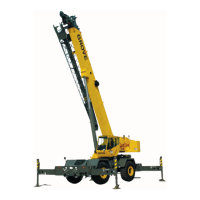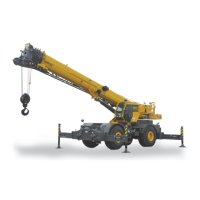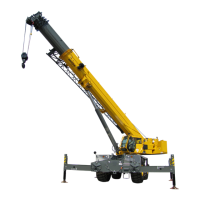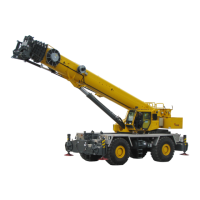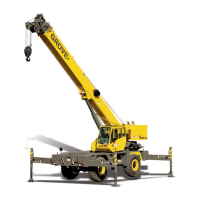Grove Published 11-10-2014, Control # 524-00 2-17
RT880E SERVICE MANUAL HYDRAULIC SYSTEM
4. If gear pump is equipped with 7/16-20 UN-2B port(s),
wait for a solid stream of fluid, free of air bubbles, to exit
the port, then re-install the plug while oil is still coming
out; torque plug to 10 lb-ft (13.6 Nm).
If gear pump is not equipped with 7/16-20 UN-2B port(s),
wait for a solid stream of fluid, free of air bubbles, to exit
the loose hose connection, then re-tighten the hose
fitting while oil is still coming out; refer to Hydraulic
Fittings, page 1-13 for proper tightening procedure.
5. Perform this step on gear pumps that start up against
high pressure, such as service brake charging or
sequence valve circuits.
With the compressed air supply (nominal 100 psi (6.9
bar), maximum 300 psi (20.7 bar)) still attached to the
Pump Priming Tool, slightly loosen the outlet port hose
of the pump. Jog the engine starter until a solid stream of
fluid, free of air bubbles, exits the loose hose
connection, then re-tighten the hose fitting while oil is
still coming out; refer to Hydraulic Fittings, page 1-13 for
proper tightening procedure.
6. If the pump’s hydraulic circuit includes an air condition-
ing compressor motor, ensure this function is turned off.
7. With the compressed air supply (nominal 100 psi (6.9
bar), maximum 300 psi (20.7 bar)) still attached to the
Pump Priming Tool, start the engine and let it idle for two
to three minutes with NO crane functions actuated.
Check for leaks and repair if required.
If the pump outlet becomes too hot to keep your hand on
it comfortably, stop the engine immediately.
8. Stop the engine and remove the Pump Priming Tool and
re-install the breather.
9. Start the engine. Slowly increase the engine speed to
approximately 1500 rpm and hold for approximately 1
minute while making sure the hydraulic reservoir is filled
to the proper level and the fluid is not aerated.
10. Slowly increase the engine speed to full RPM and hold
for 1 minute while making sure the hydraulic reservoir is
filled to the proper level and the fluid is not aerated.
11. At full engine RPM, cycle all functions without fully
extending or retracting the cylinders to their stops to ver-
ify operation and that the pump(s) stay quiet and do not
become excessively hot.
12. Check pressure settings. Refer to Pressure Setting Pro-
cedures, page 2-21.
